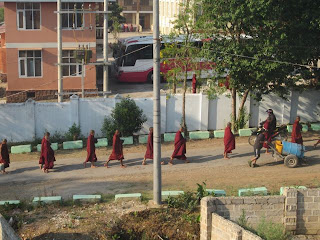We were woken on Sunday morning by the sounds of chants and gongs,
as the village of Kalaw came alive. The novice monks were gathering alms as we
walked through the streets of this former hill station in the Shan hills. Here
there is a mix of cultures and religions. There
is a mosque, a Buddhist temple and monastery, a Hindu temple, a large Catholic
church as well as an Anglican and Baptist church. Kalaw was developed during
the time of British colonization when workers from India and Nepal came to
build the railroad and then stayed to live and mix with the Shan people who had
lived here for centuries.
Novice monks in Kalaw return from collecting alms
Novice monks in Kalaw return from collecting alms
Kalaw is now the stepping off point for the many trekkers who come
to visit this part of Myanmar. There are trails throughout the hills, some that
pass through more remote areas going as far as tribes like the Palaung of the
long-neck ladies. Our trek of 2 days was from Kalaw to Inle Lake. We were
accompanied by a guide, a Shan native himself, as well as three porters from the
local Danu tribe. One of these was our chef, the other two were porters who
offered to carry our back packs if we were too hot . We were hot and had sore feet, but did not
ask to have our day packs carried. A question of pride! Our overnight bags were
driven on to Inle lake and we carried only basic requirements for the night.
The trek took us through villages where the local children ran out
to greet us. The Burmese are known as the smiling people with good reason. Our
guide talked about the strong sense of community in this area.
We walked across fields being plowed by hand, and saw women and
children hoeing the ground before planting. The soil is rich here. They grow potatoes, mustard, wheat (for
export because they do not eat bread) and other crops. Each villager has fields
that he works and then he helps his fellow villagers work theirs. The men do
the planting but the women then tend the fields while the men make bamboo
baskets to take to market. As we walked we saw scenes that could be from another
century., The people smiled and greeted us, as they slowly worked in the baking
sun.
Pa-O woman
Pa-O woman
Our lunch the first day was taken in a small home belonging to a
local man and his daughter. Our chef started chopping vegetables, garlic and
shallots, and then when his fire was ready he cooked gourmet Shan food. We sat
on the floor and devoured the feast. I wondered where all the food had been
hidden when we were walking. Our guide told us that they had stopped at the
market earlier and bought basic necessities. This was repeated at supper and
again for lunch the next day. It was simple Shan food that tasted like 5 star
restaurant fare. All washed down with green tea.
We spent the night in a monastery, where in a large room curtains
were hung for our privacy and mats spread on the floor. The 15 novices were
spread out on mats throughout the room, as were our porters and guide. The monk
was off on monastery business so the novices ages 8 to 14, were on their own
until a local village man came to settle them for the night. We could hear them
giggling and whispering before falling asleep. Our guid tolde us that this
would not be their routine if the monk were there. So « when the monk is
away, the novices do play ».
The funniest part was when the resident cat caught a huge mouse. The
boys were very excited, and ran around and under the Buddha image in his
shrinei, chasing the cat. These boys from the mountain villages live at the
monastery where they get an education. They are far from their families for
very long times. This seems to be common in Myanmar. The boys were like any
other children of that age, despite the rigors of their monastic life.





No comments:
Post a Comment